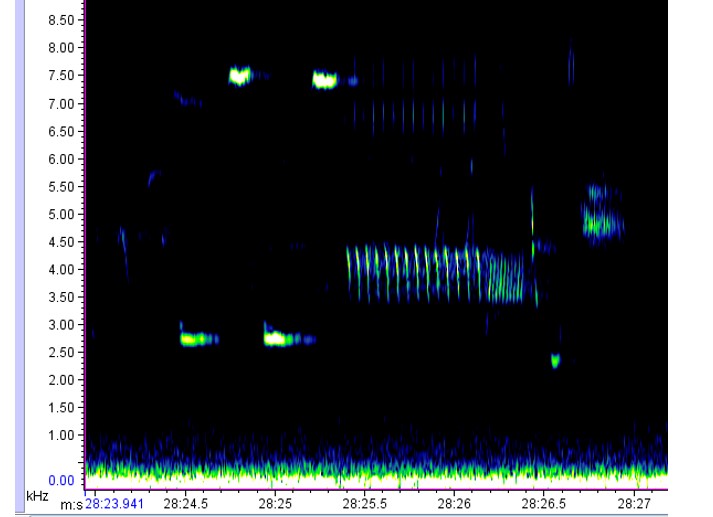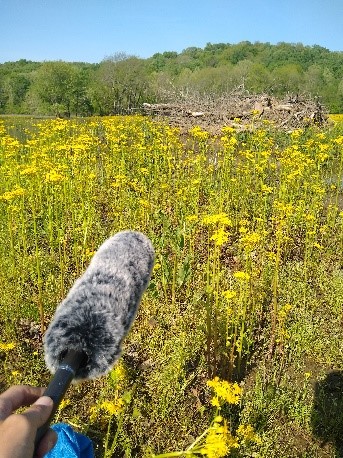Blog post by Dustin Brewer and Adam Fudickar. Read the full paper here. Photo above of a song sparrow by Mark Hainen
Studying the behavior of animals is like eating a cake and trying to figure out what made it taste the way that it does. Our changing world has baked a spectacular diversity of behaviors into the lives of animals which we are only beginning to understand. Hibernating Arctic ground squirrels, bugling elk, and migrating fish, for example, provide curious people much to feast on, as do multitudes of other species.
Given that behaviors must occur at the right time of year for a species to survive and reproduce, changing conditions can result in mismatches between an animal’s behavior and environment. For example, if an Arctic ground squirrel is still hibernating when its preferred food source is most available, then that squirrel may later starve. When such a mismatch happens, an individual, population, or even a species could disappear from the Earth. For this reason, studying animal behavior can inform conservation efforts in addition to allowing us to ‘eat a tasty cake’ for the fun of it.
Animals often rely on environmental cues to initiate behaviors. For example, a bird that has migrated to Florida for the winter might migrate back to where it breeds in the spring based on daylength, which also affects when it sings. For many bird species, singing is the primary way for males to attract mates and defend territories.
We asked a simple question, which was, ‘how often, and when, do individual birds that don’t migrate sing compared to individuals that do migrate?’ For some bird species, like Song Sparrows, the breeding population at a location can consist of both ‘residents’ (they spend the entire year where they breed) and ‘migrants’ (they spend the winter away from where they breed). Considering that photoperiod, the amount of time each day that an animal is exposed to daylight, varies based on latitude, we thought that there might be a difference in singing behavior between residents and migrants.
To answer this question, we caught Song Sparrows from a breeding population in Indiana just after the breeding season and randomly assigned them to separate rooms in the lab. In one room, we used photoperiod to simulate a migration from Bloomington, IN to Tampa, FL, then an entire winter in Tampa, and finally a migration back to Bloomington. We called these 10 birds ‘migrants.’ In the other room, we used photoperiod to simulate a winter spent in Bloomington until the breeding season. We called these 10 birds ‘residents.’

Throughout the 4.5 months that this study took place, we counted the number of songs that each bird in each room sang. Because each Song Sparrow has a unique repertoire of 4 to 13 song types, we were able to identify each individual by its songs and so could count the number of times that it sang, even though many of the birds were singing at the same time. We sampled on 20 November and 6 December (‘non-breeding’ stage), on 27 January and 7 February (‘pre-breeding’ stage), and on 21 March and 4 April (‘breeding’ stage). We found that little singing occurred during the non-breeding stage in the resident group, and that none of the migrants sang. In the pre-breeding stage, however, the residents sang significantly more than the migrants (about 60 songs per bird vs 26 songs per bird in one hour). During the breeding stage, we didn’t find a difference between how much the residents and migrants sang (both sang about 50 songs per bird per hour).
Our results informed us about how Song Sparrows might behave in the wild. Namely, it seems, Song Sparrows that migrate may begin singing at a high rate later than those that don’t migrate. Residents sang more than migrants during the pre-breeding stage, which could help residents establish territories where they will later breed. Given that singing and breeding often co-occur, it could be a disadvantage for migrants if they sang less than residents when they reached the breeding grounds. Our results, however, suggest that both migrants and residents sing the same amount during the beginning of the breeding stage. The act of migrating, it seems, doesn’t put Song Sparrows at a disadvantage with respect to song output during the beginning of the breeding stage.

Understanding when and how much Song Sparrow migrants and residents sing in the wild, and how much other migratory bird species do the same, could help to determine how strategies such as migration affect the ability of individuals to compete for mates. Also, studies like ours could help to determine how much variability exists in the timing of breeding within a population. For example, if migrants begin singing (and breeding) a couple weeks later than residents, then that breeding population of birds would possess variability which could help it to withstand environmental changes, such as climate change.
Our study primarily helps to understand the interplay between two awe-inspiring behaviors, bird migration and bird song. Additionally, our study could provide a framework for determining how much variability in timing of singing (and breeding) particular species display, which could inform conservationists about which species have a better chance of withstanding environmental changes. If so, then we could ‘have our cake and conserve, too.’

very informative , and interesting
LikeLike
Hello I’m from Vancouver BC and I can’t find the answer
“Do migrant birds change their song when they come back from the south and can you tell me a few birds that change their song
Thanks for your very interesting article
LikeLike
very interesting and in fact I’ve often wondered about that difference between residents and migrants
Juliet
http://craftygreenpoet.blogspot.com
LikeLike